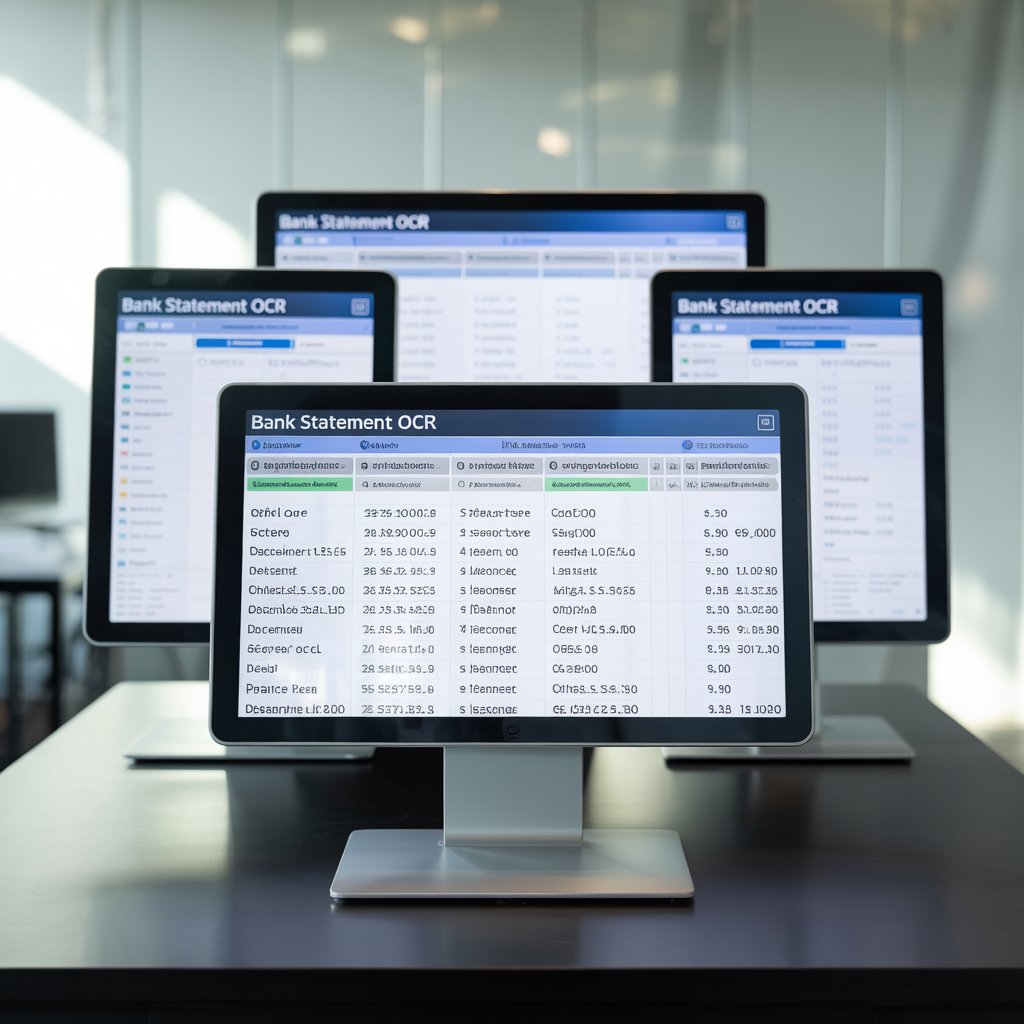Optical Character Recognition (OCR) is a technology that converts different types of documents—such as scanned paper documents, PDF files, or images captured by a digital camera—into editable and searchable data. In the context of payments, OCR technology extracts text from payment-related documents such as invoices, receipts, and bank statements, transforming them into machine-readable data that can be processed automatically.
At its core, payment OCR serves as a bridge between the physical and digital worlds of financial documentation. Rather than manually entering data from physical documents into digital systems—a process fraught with inefficiencies and potential errors—OCR automates this conversion, ensuring speed, accuracy, and cost-effectiveness.
How Bank Statement OCR Is Revolutionizing Financial Document Processing
Bank statement OCR represents one of the most significant applications of OCR technology in the financial sector. Traditional bank statements arrive as printed documents or PDF files that require manual processing. This process is not only time-consuming but also prone to human error, potentially leading to discrepancies in financial records.
With bank statement OCR, financial institutions and businesses can automatically extract relevant information from bank statements, including:
- Transaction details
- Account numbers
- Payment amounts
- Transaction dates
- Merchant information
- Reference numbers
The advanced algorithms in modern bank statement OCR solutions can identify and capture this information accurately, even from documents with varying formats and layouts. The extracted data can then be seamlessly integrated into accounting systems, payment processing platforms, or financial management software, eliminating the need for manual data entry.
Key Benefits of OCR in Payment Processing
The implementation of OCR technology in payment processing offers numerous advantages for businesses, financial institutions, and individual users:
1. Enhanced Efficiency and Speed
OCR dramatically reduces the time required to process payment documents. What might take hours or even days when done manually can be accomplished in minutes with OCR. This efficiency translates to faster payment cycles, improved cash flow, and better resource allocation.
2. Reduced Error Rates
Human data entry inevitably leads to errors, whether through typos, misinterpretation, or simple oversight. OCR significantly reduces these errors, ensuring greater accuracy in payment processing. Modern OCR systems achieve accuracy rates of 99% or higher, far surpassing manual data entry.
3. Cost Savings
By automating data extraction and entry, OCR reduces the need for manual labor, leading to substantial cost savings. Businesses can reallocate human resources to more value-added tasks rather than routine data entry.
4. Improved Compliance and Audit Trails
OCR systems can be programmed to identify and flag potential compliance issues in payment documents. Additionally, they create detailed digital audit trails, making it easier to track and verify transactions for regulatory compliance or internal auditing purposes.
5. Enhanced Customer Experience
Faster payment processing means improved customer satisfaction. Whether processing customer refunds, handling subscription payments, or managing invoices, OCR technology ensures a smoother, more efficient experience for all parties involved.
Applications of OCR in Various Payment Scenarios
OCR technology finds application across a wide range of payment processing scenarios:
Invoice Processing
OCR can extract key information from invoices, including invoice numbers, due dates, amounts, and vendor details. This data can be automatically entered into accounts payable systems, facilitating quicker payment processing and better vendor relationships.
Receipt Management
For expense tracking and reimbursement, OCR can scan and extract data from receipts, eliminating the need for manual expense reports. This is particularly valuable for businesses with frequent business travel or numerous reimbursable expenses.
Check Processing
Despite the rise of digital payments, checks remain common in many business contexts. OCR technology can read and process check information, including the amount, payee details, and check number, streamlining the check deposit and clearance process.
Bank Statement Reconciliation
Bank statement OCR is instrumental in automating the reconciliation process. By extracting transaction data from bank statements and comparing it with internal records, businesses can quickly identify discrepancies and resolve them, ensuring accurate financial reporting.
Payment Card Processing
OCR can capture information from payment cards, facilitating easier setup of recurring payments or quick entry of card details for online transactions.
The Technical Side of Payment OCR
Modern payment OCR systems employ sophisticated technologies to ensure accurate data extraction:
Machine Learning and AI
Advanced OCR systems leverage machine learning algorithms that improve over time. As the system processes more documents, it becomes better at recognizing different fonts, layouts, and formats, enhancing its accuracy and adaptability.
Natural Language Processing (NLP)
NLP enables OCR systems to understand the context of the extracted text, helping to categorize information correctly. For instance, it can distinguish between a total amount and a subtotal on an invoice, even if they’re not clearly labeled.
Template-Based Recognition
Some OCR systems use templates for common document types, such as standard invoice formats or specific bank statements. This approach enhances accuracy for frequently processed document formats.
Cloud-Based Processing
Many modern OCR solutions operate in the cloud, offering scalability, accessibility, and regular updates without requiring significant on-premises infrastructure.
Implementing OCR in Your Payment Systems
For businesses considering the implementation of OCR technology in their payment processes, several factors warrant consideration:
Integration with Existing Systems
The OCR solution should seamlessly integrate with your existing financial management systems, including accounting software, ERP systems, and payment platforms.
Customization and Flexibility
Look for OCR solutions that can be customized to recognize and process the specific document formats relevant to your business operations.
Security and Compliance
Given the sensitive nature of payment information, robust security features are essential. Ensure that the OCR solution complies with relevant data protection regulations and industry standards.
Scalability
As your business grows, your OCR solution should scale accordingly. Choose a solution that can handle increasing document volumes without compromising on speed or accuracy.
The Future of OCR in Payment Processing
The evolution of OCR technology continues to reshape payment processing landscapes:
Mobile OCR
With the proliferation of smartphones, mobile OCR applications are gaining traction. These apps allow users to capture and process payment documents on the go, further streamlining payment workflows.
Real-Time Processing
Advances in computing power and algorithms are enabling real-time OCR processing, allowing for instantaneous data extraction and verification.
Enhanced Accuracy Through Deep Learning
Deep learning techniques are pushing OCR accuracy to new heights, particularly for complex documents or those with poor image quality.
Broader Integration with Payment Ecosystems
OCR is increasingly becoming an integral part of broader payment ecosystems, working in tandem with digital payment platforms, blockchain systems, and automated accounting solutions.
Challenges and Considerations in Payment OCR
Despite its many advantages, OCR in payment processing isn’t without challenges:
Document Quality Issues
Poor-quality scans, faded text, or non-standard formats can impact OCR accuracy. Businesses should establish guidelines for document handling to mitigate these issues.
Initial Setup Costs
Implementing a comprehensive OCR solution may require significant initial investment, though the long-term ROI typically justifies these costs.
Training Requirements
Staff may need training to use OCR systems effectively and troubleshoot potential issues.
Regular Updates and Maintenance
OCR systems require regular updates to maintain accuracy and security, necessitating ongoing technical support.
Conclusion: The Transformative Power of OCR in Payment Processing
OCR technology has fundamentally transformed payment processing, offering unprecedented efficiency, accuracy, and cost-effectiveness. From bank statement OCR to invoice processing and receipt management, OCR applications are streamlining financial operations across industries.
As businesses continue to embrace digital transformation, OCR stands out as a pivotal technology for modernizing payment systems. By automating data extraction and entry, OCR not only reduces operational costs but also enhances the overall payment experience for businesses and their customers.
Looking ahead, the continued evolution of OCR technology—through advancements in AI, machine learning, and integration capabilities—promises even greater innovations in payment processing. For businesses aiming to stay competitive in an increasingly digital financial landscape, exploring and implementing OCR solutions is not just an option but a strategic imperative.
Q: What is the difference between OCR and ICR?
A: While OCR (Optical Character Recognition) recognizes printed text, ICR (Intelligent Character Recognition) can recognize handwritten text as well. In payment processing, ICR is particularly useful for documents with handwritten elements, such as manually filled forms or signed checks.
Q: Is bank statement OCR secure?
A: Yes, modern bank statement OCR solutions implement robust security measures, including encryption, secure data transmission, and compliance with financial industry standards. However, businesses should conduct due diligence when selecting an OCR provider to ensure adequate security protocols.
Q: Can OCR technology process documents in multiple languages?
A: Yes, advanced OCR systems support multiple languages, making them valuable for businesses operating internationally or processing payments from global clients.
Q: How accurate is OCR for payment processing?
A: Modern OCR systems achieve accuracy rates of 95-99%, depending on document quality and format consistency. Machine learning enhancements continue to improve these rates.
Q: What types of businesses benefit most from payment OCR?
A: While businesses of all sizes can benefit from OCR, it’s particularly valuable for organizations that process high volumes of payment documents, such as financial institutions, accounting firms, insurance companies, and enterprises with complex accounts payable departments.
Q: How does OCR complement other payment technologies?
A: OCR works synergistically with other payment technologies, such as electronic payment systems, digital wallets, and automated reconciliation tools, creating comprehensive payment ecosystems that maximize efficiency and accuracy throughout the payment lifecycle.



